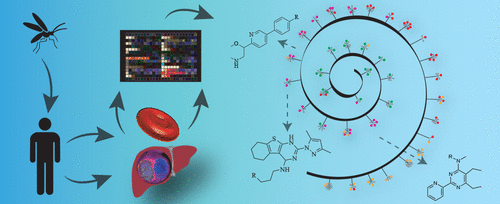当前位置:
X-MOL 学术
›
ACS Infect. Dis.
›
论文详情
Our official English website, www.x-mol.net, welcomes your
feedback! (Note: you will need to create a separate account there.)
Probing the Open Global Health Chemical Diversity Library for Multistage-Active Starting Points for Next-Generation Antimalarials.
ACS Infectious Diseases ( IF 4.0 ) Pub Date : 2020-03-04 , DOI: 10.1021/acsinfecdis.9b00482 Matthew Abraham 1 , Kerstin Gagaring 2 , Marisa L Martino 1 , Manu Vanaerschot 3 , David M Plouffe 4 , Jaeson Calla 1 , Karla P Godinez-Macias 1 , Alan Y Du 1 , Melanie Wree 1 , Yevgeniya Antonova-Koch 1 , Korina Eribez 1 , Madeline R Luth 1 , Sabine Ottilie 1 , David A Fidock 3, 5 , Case W McNamara 2 , Elizabeth A Winzeler 1
ACS Infectious Diseases ( IF 4.0 ) Pub Date : 2020-03-04 , DOI: 10.1021/acsinfecdis.9b00482 Matthew Abraham 1 , Kerstin Gagaring 2 , Marisa L Martino 1 , Manu Vanaerschot 3 , David M Plouffe 4 , Jaeson Calla 1 , Karla P Godinez-Macias 1 , Alan Y Du 1 , Melanie Wree 1 , Yevgeniya Antonova-Koch 1 , Korina Eribez 1 , Madeline R Luth 1 , Sabine Ottilie 1 , David A Fidock 3, 5 , Case W McNamara 2 , Elizabeth A Winzeler 1
Affiliation

|
Most phenotypic screens aiming to discover new antimalarial chemotypes begin with low cost, high-throughput tests against the asexual blood stage (ABS) of the malaria parasite life cycle. Compounds active against the ABS are then sequentially tested in more difficult assays that predict whether a compound has other beneficial attributes. Although applying this strategy to new chemical libraries may yield new leads, repeated iterations may lead to diminishing returns and the rediscovery of chemotypes hitting well-known targets. Here, we adopted a different strategy to find starting points, testing ∼70,000 open source small molecules from the Global Health Chemical Diversity Library for activity against the liver stage, mature sexual stage, and asexual blood stage malaria parasites in parallel. In addition, instead of using an asexual assay that measures accumulated parasite DNA in the presence of compound (SYBR green), a real time luciferase-dependent parasite viability assay was used that distinguishes slow-acting (delayed death) from fast-acting compounds. Among 382 scaffolds with the activity confirmed by dose response (<10 μM), we discovered 68 novel delayed-death, 84 liver stage, and 68 stage V gametocyte inhibitors as well. Although 89% of the evaluated compounds had activity in only a single life cycle stage, we discovered six potent (half-maximal inhibitory concentration of <1 μM) multistage scaffolds, including a novel cytochrome bc1 chemotype. Our data further show the luciferase-based assays have higher sensitivity. Chemoinformatic analysis of positive and negative compounds identified scaffold families with a strong enrichment for activity against specific or multiple stages.
中文翻译:

探索开放的全球健康化学多样性库,寻找下一代抗疟药的多阶段活性起点。
大多数旨在发现新的抗疟化学型的表型筛选都是从针对疟疾寄生虫生命周期的无性血液阶段(ABS)的低成本、高通量测试开始。然后,对 ABS 具有活性的化合物随后在更困难的测定中进行测试,以预测化合物是否具有其他有益属性。尽管将此策略应用于新的化学库可能会产生新的线索,但重复迭代可能会导致收益递减以及重新发现符合已知目标的化学型。在这里,我们采用了不同的策略来寻找起点,并行测试了全球健康化学多样性库中约 70,000 种开源小分子对肝脏阶段、成熟性阶段和无性血液阶段疟原虫的活性。此外,我们没有使用在化合物(SYBR绿)存在下测量积累的寄生虫DNA的无性测定,而是使用实时荧光素酶依赖性寄生虫活力测定来区分慢效(延迟死亡)和快效化合物。在 382 个通过剂量反应 (<10 μM) 证实具有活性的支架中,我们还发现了 68 种新型延迟死亡抑制剂、84 种肝阶段抑制剂和 68 种 V 期配子体抑制剂。尽管 89% 的评估化合物仅在单个生命周期阶段具有活性,但我们发现了六种有效的(半最大抑制浓度为 <1 μM)多阶段支架,包括一种新型细胞色素 bc1 化学型。我们的数据进一步表明基于荧光素酶的检测具有更高的灵敏度。对阳性和阴性化合物的化学信息学分析确定了具有针对特定或多阶段活性的强烈富集的支架家族。
更新日期:2020-02-20
中文翻译:

探索开放的全球健康化学多样性库,寻找下一代抗疟药的多阶段活性起点。
大多数旨在发现新的抗疟化学型的表型筛选都是从针对疟疾寄生虫生命周期的无性血液阶段(ABS)的低成本、高通量测试开始。然后,对 ABS 具有活性的化合物随后在更困难的测定中进行测试,以预测化合物是否具有其他有益属性。尽管将此策略应用于新的化学库可能会产生新的线索,但重复迭代可能会导致收益递减以及重新发现符合已知目标的化学型。在这里,我们采用了不同的策略来寻找起点,并行测试了全球健康化学多样性库中约 70,000 种开源小分子对肝脏阶段、成熟性阶段和无性血液阶段疟原虫的活性。此外,我们没有使用在化合物(SYBR绿)存在下测量积累的寄生虫DNA的无性测定,而是使用实时荧光素酶依赖性寄生虫活力测定来区分慢效(延迟死亡)和快效化合物。在 382 个通过剂量反应 (<10 μM) 证实具有活性的支架中,我们还发现了 68 种新型延迟死亡抑制剂、84 种肝阶段抑制剂和 68 种 V 期配子体抑制剂。尽管 89% 的评估化合物仅在单个生命周期阶段具有活性,但我们发现了六种有效的(半最大抑制浓度为 <1 μM)多阶段支架,包括一种新型细胞色素 bc1 化学型。我们的数据进一步表明基于荧光素酶的检测具有更高的灵敏度。对阳性和阴性化合物的化学信息学分析确定了具有针对特定或多阶段活性的强烈富集的支架家族。











































 京公网安备 11010802027423号
京公网安备 11010802027423号